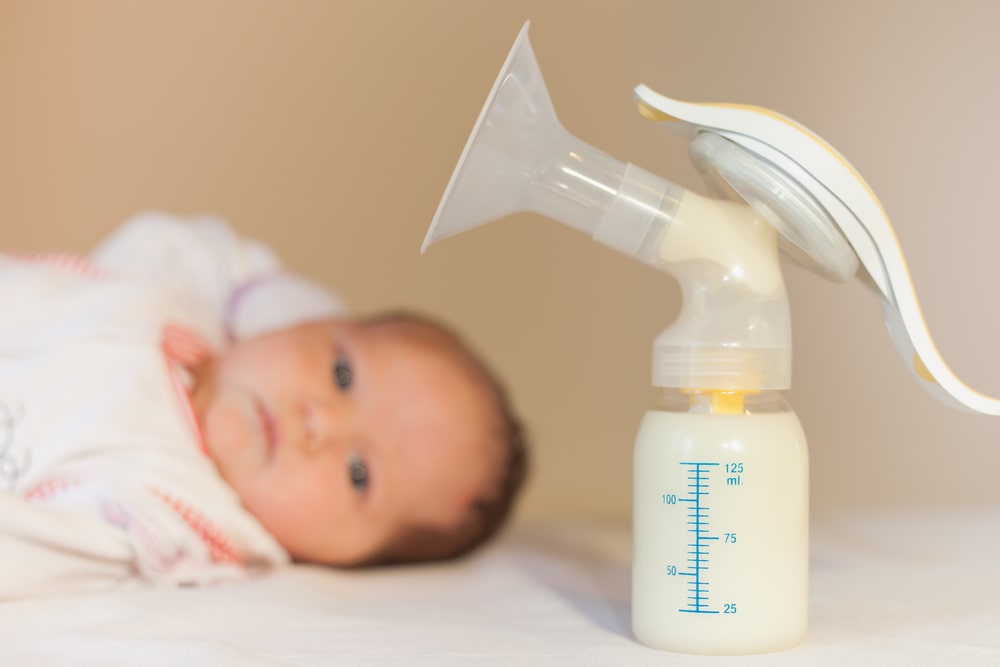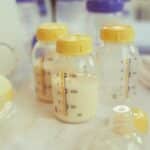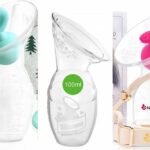It can be frustrating when you’re breastfeeding your little one, but they always seem to be hungry.
Other babies are satisfied for hours after feeding, but yours is screaming to nurse once you hit the one-hour mark. It often leads to one mother comparing herself to another, and feelings of inadequacy.
It’s important to realize that you are, in fact, enough. Not only are you enough, but you’re also doing a great job! Breastfeeding is tough work, and you’re no doubt exhausted.
There are a few tips that you can use to make sure that your baby is satisfied after each feeding.
Make Sure Your Baby Drinks From One Breast Until It’s Empty
When you’re breastfeeding, it’s important that your little one drink from one breast until that one is empty. Then, switch the baby over to the other breast.
Typically, the milk in the front of the breast is a bit thinner and has less fat than milk towards the hind part of the breast.
This means that if your baby doesn’t empty one breast before being switched to the other, they are missing out on the extra fat, which is what will keep them full longer.
To avoid this, it’s important that the baby actually finish the milk on one breast. To determine if the breast is empty or not, watch for these signs:
- The breast will appear a bit more floppy than when it is full
- It’s almost impossible to hand express milk
- The baby comes off the breast on its own
It may only take a little one ten minutes to empty a breast on their own. However, some babies tend to eat slowly. That means it can take longer, such as 20-30 minutes to empty one breast. Instead of timing it, watch for the cues mentioned above.
Don’t Forget To Alternate Breasts
One of the main reasons why breastfeeding mothers find it hard to stick to this is due to one breast winding up engorged.
If a baby empties one breast but doesn’t empty the other, the second breast can be full again rather quickly. This is why some people recommend feeding on each breast for twenty minutes. It helps even things out.
However, that method can also mean your little one gets less fat in their milk. So, alternate which breast you begin feeding times with.
If you start feeding on the right, make sure to start the next feeding on the left. Alternating breasts can help prevent engorgement and the pain that comes with it.
Sooth Engorgement Pain To Make It Easier For You To Let Your Baby Feed Until The Breast Is Empty
[amalinkspro type=”showcase” asin=”B005P0KNZW” apilink=”https://www.amazon.com/dp/B005P0KNZW?tag=mominformedcom-20&linkCode=osi&th=1&psc=1″ new-window=”true” addtocart=”false” nofollow=”true” sc-id=”4″ imgs=”LargeImage” link-imgs=”false” specs=”velour side: 65% bamboo rayon/25% cotton/10% polyester, jersey side:95% bamboo viscose/5% spandex~~~imported~~~pain relief: helps soothe and comfort sore nipples and breasts to provide different levels of temperature control~~~double-sided: rayon velour (65% bamboo rayon/25% cotton/10% polyester) / rayon jersey (95% bamboo viscose/5% spandex)” btn-color=”#ff9900″ btn-text=”Check Price” alignment=”aligncenter” hide-prime=”0″ hide-image=”0″ hide-price=”0″ hide-button=”0″ width=”750″]Bamboobies Soothing Nursing Pillows with Flaxseed[/amalinkspro]
Sometimes, even if you alternate which breast you start with, your breasts will still become engorged. It can be painful for you to let your little one continue to nurse on one breast if it is already swollen and tender.
Engorged breasts can also make it difficult for your baby to eat, which will lead to them acting as though the breast is empty even though it is not.
Instead, what is happening is that the baby is drinking the milk in the front, but is having a hard time feeding so they are ready to switch. This results in them not getting the hindmilk that they need to fill them up.
These tips will help you soothe the pain of engorgement so that it’s not as painful for a little one to eat, and to make sure they will eat to empty the breast.
Understand What Causes Engorgement
Typically, engorgement is the result of your breast producing more milk than your baby is eating. This results in the breast being too full. It can make your breasts hard and overfull of milk.
Sometimes, this is due to the baby not feeding as much from one breast. It can also be caused by you not leaving your baby on one breast due to obvious reasons, such as a cracked and painful nipple.
Whatever the reason, the underlying cause of engorgement is still the same: too much milk.
Address Feeding Issues With That Breast
If there is an underlying issue with one particular breast, it’s important to address that. Cracked, painful nipples can make breastfeeding a miserable experience.
Pick up some good nipple cream to help ease the discomfort. If you can’t seem to get comfortable when your little one is latched onto one breast, consider using a boppy pillow for additional support.
Use Hot And/Or Cold Compresses
Utilizing hot and cold compresses or simply taking a nice, warm shower can help ease the pain that comes with engorgement.
Heat can help make the breast softer, and easier for your baby to eat, too. Use a heating pad, warm shower, or another warm compress.
View in gallery
Express The Milk
Use your hand or a breast pump to express some of the milk until it’s the next time for your baby to eat. This can also help alleviate the pain and engorgement because your breast will no longer be too full of milk.
However, it’s important to only express or pump enough milk so that you are not in pain. Your body creates milk on a supply and demand basis.
When you pump milk, your body interprets that as your baby eating. Then, it takes that as a cue to produce more milk. Pumping in addition to feeding your little one can start a cycle of you consistently producing too much milk.
This will lead to you having engorged breasts almost constantly. Instead, only pump enough so that you feel better and your baby can comfortably eat.
Address Oversupply Issues
Sometimes, we produce so much milk that our baby simply can’t drink it all. This is what’s known as oversupply. Constant bouts of mastitis and engorgement are common if you have an oversupply problem.
Remember that when your breasts are engorged, it’s harder for your baby to feed, which can lead to them not getting the fat at the back of the breast.
This, and the obvious discomfort and medical reasons, make it important to take care of this. Check out this article if you’re dealing with an oversupply of breast milk.
Try A Lactation Massager
A lactation massager is a great thing to have if you are breastfeeding. These can serve multiple purposes! They help relieve the pain that comes with engorgement.
Lactation massagers can double as gum massagers for teething babies. If you find that your little one is still acting hungry soon after eating, but they aren’t eating enough to empty one breast, this is the answer you’ve been looking for!
A lactation massager, when used regularly, can help move the hindmilk from the back of your breast closer to the front so your little one can get to it.
[amalinkspro type=”showcase” asin=”B07MZCR4BQ” apilink=”https://www.amazon.com/dp/B07MZCR4BQ?tag=mominformedcom-20&linkCode=osi&th=1&psc=1″ new-window=”true” addtocart=”false” nofollow=”true” sc-id=”4″ imgs=”LargeImage” link-imgs=”false” specs=”IMPROVE YOUR BREAST MILK FLOW: Breast massage is an important part of maintaining proper milk flow. The LaVie lactation massage roller helps make breast massage easy. The massage roller will help make emptying breasts easier and give your hands a break.~~~~~~~~~” btn-color=”#ff9900″ btn-text=”Check Price” alignment=”aligncenter” hide-prime=”0″ hide-image=”0″ hide-price=”0″ hide-button=”0″ width=”750″]LaVie Lactation Massage Roller[/amalinkspro]
How To Increase Your Milk Supply
If your little one is emptying both breasts, but still acts hungry an hour later, they might not be getting enough to eat. This might be due to your milk supply having a hard time keeping up with your baby.
Although milk is produced on a supply and demand basis, it’s important to note that sometimes this doesn’t always work out as planned.
Sometimes, you need to do something else to help your supply keep up with your baby. These tips will help you increase your milk supply so that your baby is getting enough to eat, and so that you don’t have to supplement with formula.
Avoid Foods That Decrease Your Milk Supply
There are certain spices, herbs, and foods that are known to decrease your milk supply. Consuming them in large quantities will definitely reduce your milk supply. Try not to include these foods in your diet:
- Oregano
- Thyme
- Large amounts of vitamin B6 (this is found in a lot of breakfast cereals, potatoes, hummus, and chicken.) It’s an important part of a healthy diet, but you don’t want to overdo it.
- Parsley
- Peppermint
- Licorice tea
- Spearmint
- Ginseng
- Cough drops, particularly menthol cough drops
- Cabbage
- Alcohol
- Decongestant medications
- Lemon balm
- Sage
- Birth control
These are some of the most common foods that are known for causing a decrease in milk production.
In fact, some of them are used by mothers that are ready to stop breastfeeding, such as cabbage leaves. Make sure to avoid these in your diet if you’re trying to increase your milk supply.
View in gallery
Stay Hydrated
Mothers that are not properly hydrated don’t produce as much milk as those that are. If your body is trying to hold onto as many fluids as it can, it won’t have as many to give out to your baby.
Your body also doesn’t work as well as it should if it’s dehydrated. Remember, it’s possible to be mildly dehydrated and not even know it! Make sure that you drink plenty of healthy fluids while you’re breastfeeding.
Lactating mothers often need more fluids than other people do, so it’s a great idea to carry a bottle of water in your handbag.
Try Lactation Tea Or Supplements
There are plenty of products available on the market that are designed to help you boost your milk supply. These are available in teas and other types of supplements.
They are packed with things that are going to help you increase your milk supply, like this one:
[amalinkspro type=”showcase” asin=”B01K4C9KUO” apilink=”https://www.amazon.com/dp/B01K4C9KUO?tag=mominformedcom-20&linkCode=osi&th=1&psc=1″ new-window=”true” addtocart=”false” nofollow=”true” sc-id=”4″ imgs=”LargeImage” link-imgs=”false” specs=”Increase milk supply for your baby: Organic fenugreek seed, fennel seed and milk thistle all combine to encourage your system to produce more breast milk. With organic, non-gmo ingredients, you can count on pure mom to be gentle on your body while stimulating lactation.~~~~~~~~~” btn-color=”#ff9900″ btn-text=”Check Price” alignment=”aligncenter” hide-prime=”0″ hide-image=”0″ hide-price=”0″ hide-button=”0″ width=”750″]Organic Breastfeeding Supplement[/amalinkspro]
Eat A Healthy Diet, And Eat When You’re Hungry
When you’re breastfeeding is not the time to start a new diet. It can be tempting to get motivated to lose that baby weight, but your body needs to focus more on providing for your little one.
If it is not receiving proper nutrients or a high enough number of calories, it won’t be able to do that as well. This can lead to a milk supply that just isn’t enough.
Breastfeeding mothers usually need 2300-2800 calories daily. This is an extra 500 compared to what they needed before getting pregnant. Keep this in mind when you’re eating.
If you’re not eating enough, consider keeping a food diary to keep track of how much you’re eating, and to make sure that you’re eating a healthy diet.
Pump More Often
Power pumping is when you pump your milk every hour or so in between feedings. Your body will begin to produce more milk because it thinks that your baby is eating more.
This might take a little bit of time to work, but the sooner you get started the sooner you will see your milk supply increase.
If you’re interested in learning more about how to power pump to increase your milk supply, check out this article. It goes into a lot of detail and gives specific instructions so that you can make this method work for you.
Consult Your Doctor
There are medications that can help you produce more breastmilk.
If you’re out of other options, and this is a consistent problem, consider talking to your doctor or a lactation specialist about them. They can also recommend other alternatives that you might not know about.
Consider That Your Baby Might Be Using You For A Pacifier
View in gallery
It’s more than possible that your little one could simply be using you for a pacifier. If you notice that they are suckling but your breast never seems to empty, they might not be eating.
This is because some babies prefer to use the breast as their personal pacifier. They might be upset or need comfort.
If you think that they are eating, but they are hungry again within an hour, this is something to look for. You’ll notice that your baby tends to suckle when they are tired.
They also won’t suck as hard on the breast if they are using you as a pacifier, either. This is because they aren’t hungry.
In Conclusion
If your breastfed baby seems to be constantly hungry, make sure that they are eating the hindmilk in the breast. Ensure that they are able to eat properly, and aren’t having problems due to the breasts being engorged.
Then, make sure that you have an adequate milk supply. This should help you learn why your little one acts as though they are always hungry, and what you can do about it.






